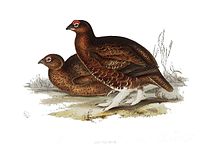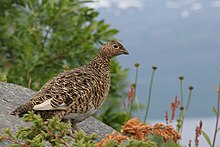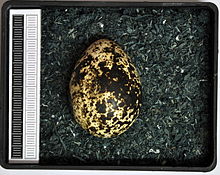Willow ptarmigan
| Willow ptarmigan | |
|---|---|

| |
| Adult Alaskan willow ptarmigan (L. l. alascensis) in summer plumage, Denali National Park
| |
| Scientific classification | |
| Domain: | Eukaryota |
| Kingdom: | Animalia |
| Phylum: | Chordata |
| Class: | Aves |
| Order: | Galliformes |
| Family: | Phasianidae |
| Genus: | Lagopus |
| Species: | L. lagopus
|
| Binomial name | |
| Lagopus lagopus | |

| |
| Willow Grouse range[2] | |
| Synonyms | |
|
Lagopus albus | |
The willow ptarmigan (
Description
The willow ptarmigan is a medium to large ground-dwelling bird and is the most numerous of the three species of ptarmigan. Males and females are about the same size, the adult length varying between 35 and 44 centimetres (14 and 17 in) with a wingspan ranging from 60 and 65 centimetres (24 and 26 in). The weight is 430 to 810 grams (15 to 29 oz). It is deep-chested and has a fairly long neck, a broad bill, short feathered legs and a moderately short rounded tail. In the summer, the male's plumage is marbled brown, with a reddish hue to the neck and breast, a black tail and white wings and underparts. It has a red semicircular comb above each eye, which become red and prominent in the breeding season. The female is similar in appearance but with much smaller eye combs and has brown feathers scattered among the white feathers on her belly. During winter, the body plumage and two central tail feathers of both sexes becomes completely white, except for the black outer rectrices. Their wing feathers remain white all year round. Immature birds resemble the adults.[3][4]

The willow ptarmigan can be distinguished from the closely related rock ptarmigan (Lagopus muta) by its larger size and thicker bill and by the fact that it is not generally found above the tree line while the rock ptarmigan prefers more elevated, barren habitat. The summer plumage is browner and in the winter, the male willow ptarmigan lacks the rock ptarmigan's black stripe between the eyes and bill.[3] The white-tailed ptarmigan (Lagopus leucura) in North America is smaller, has a white tail and finely-barred greyer plumage and lives permanently above the tree line.[5] The distinctive British Isles subspecies L. l. scoticus (red grouse) was once considered a separate true British species but is now classified as a sub-species. This moorland bird is reddish brown all over, except for its white feet.[6]
The voice is low-pitched and guttural and includes chuckles, repeated clucking sounds, and expostulations. When displaying, the male makes rattles and barking noises.[3]
Taxonomy and systematics




The willow ptarmigan's
Subspecies
The willow ptarmigan has 16 recognized subspecies.[8] Most differ little in appearance, though the red grouse (L. l. scoticus) is rather distinct. The taxonomy is confused, partly because of the complicated changes in plumage several times a year and the differing color and pattern of the summer plumage:[9]
- L. l. alascensis (Swarth, 1926) - Alaska
- L. l. alba (Gmelin & JF, 1789) - Northern Canada
- L. l. alexandrae (Grinnell, 1909) - Alaska and British Columbia
- L. l. alleni (Stejneger, 1884) - Newfoundland
- L. l. brevirostris (Hesse, 1912) - Altai Mountains and Sayan Mountains
- L. l. koreni (Thayer & Bangs, 1914) - Siberia to Kamchatka peninsula
- L. l. kozlowae (Portenko, 1931) - northern Mongolia and southern Siberia
- L. l. lagopus (Linnaeus, 1758) - Scandinavia, Finland, and northern Russia
- L. l. leucoptera (Taverner, 1932) - Northernmost Arctic islands
- L. l. maior (Lorenz T, 1904) - north Kazakhstan and southwest Siberia
- L. l. okadai (Momiyama, 1928) - Sakhalin Island
- L. l. rossica (Serebrovski, 1926) - Baltic states and central Russia
- L. l. scotica (Latham, 1787) - Britain and Ireland
- L. l. sserebrowsky (Domaniewski, 1933) - Northeastern Mongolia to southeast Siberia and northeastern China
- L. l. ungavus (Riley, 1911) - Northeastern Canada
- L. l. variegata (Salomonsen, 1936) - Trondheim, Norway
The willow ptarmigan often hybridises with the black grouse (Tetrao tetrix) and the hazel grouse (Tetrastes bonasia) and occasionally with the western capercaillie (Tetrao urogallus), the spruce grouse (Falcipennis canadensis) and the rock ptarmigan (Lagopus muta).[9]
During the
Distribution and habitat
The willow ptarmigan has a
-
Distribution in North America[2]
Diet
The willow ptarmigan has a varied and seasonal diet.
In Alaska, the main dietary item of the adults at all times of year is willows such as the Alaska willow Salix alaxensis, with leaves being eaten in summer and buds, twigs and catkins supplying the birds' main nutritional needs in winter and early spring.[19] In the early twenty-first century, there has been an increase in shrub expansion in arctic Alaska that is thought to be greatly affecting the willow ptarmigan's winter diet. Because of the way they browse, Ptarmigan help shape the landscape of the area.[19] After heavy snowfalls, the birds cannot access the shorter shrubs as they are blanketed with snow, so they will eat the taller species that poke through. In one study it was found that 90% of the buds of the Alaska willow within their reach had been browsed.[19] This will stunt the willows and create a feedback cycle extending through the entire ecosystem. However, in winters with below average snowfall, the browsing of Ptarmigans will not have such a drastic effect as their feeding will be spread out across a range of lower plant species. It is also believed that the greening of parts of the Arctic is affecting Willow Ptarmigan populations by altering the shape and size of the shrubs they are able to feed on.[19]
Behavior

Male willow ptarmigans are territorial birds. Males arrive in the breeding areas and set up territories in April and May, aggressively defending them against male interlopers. When the females arrive a few weeks later, the male performs courtship displays such as aerial manoeuvres, strutting and tail-fanning. When she has chosen a mate and a nesting site, the female lays a clutch of six to ten eggs in a shallow depression on the ground. The nest site is usually in a hidden location at the edge of a clearing.[4]
A small minority of male willow ptarmigan are
Cold adaptations
The willow ptarmigan has several behavioral and physiological adaptations that help it survive the long Arctic winter, such as large pectoral muscles that aid in the process of shivering. Researchers have found that these pectoral muscles grow quickly during the first few days of the ptarmigan's life, meaning that the ptarmigan chicks go from having no thermoregulatory ability at hatch to being able to maintain their normal body temperature for hours at 10 °C when they are two weeks old.[citation needed] The rapid increase in pectoralis size is caused by increases in muscle fiber diameters (hypertrophy), and cold exposure is not necessary for this muscle development to occur.[21] Ptarmigan also have thick plumage with feather barbules that contain air-filled cavities,[22] contributing to a low heat loss, which aids in thermoregulation while the bird is roosting in burrows in the snow. Ptarmigan can withstand the severe cold because the ambient temperature in the sheltered microclimate of their snow burrows typically exceeds their lower critical temperature.[22]
Status
Widespread and not uncommon in its remote habitat, the willow ptarmigan is classified as a species of "
Title bird

The willow ptarmigan was adopted as the state bird of Alaska in 1955.[23] It is also the regional bird of Southern Lapland.[24]
See also
- Chicken, Alaska was originally going to be named "ptarmigan" in 1902, but town founders could not agree on how to spell it.[25]
References
- ^ . Retrieved 12 November 2021.
- ^ a b c BirdLife International and NatureServe (2014) Bird Species Distribution Maps of the World. 2012. Lagopus lagopus. In: IUCN 2015. The IUCN Red List of Threatened Species. Version 2015.2. http://www.iucnredlist.org. Downloaded on 8 July 2015.
- ^ a b c Braun, C. E.; Martin, K.; Robb, L. A. (1993) [last updated 20 May 2020]. "Willow Ptarmigan". All about birds. The Cornell Lab of Ornithology.
- ^ a b c d e "Willow Ptarmigan (Lagopus lagopus)". Small Game Hunting in Alaska. Alaska Department of Fish and Game. Retrieved 5 February 2013.
- ^ "White-Tailed Ptarmigan (Lagopus leucurus)". Alaska Department of Fish and Game. Retrieved 7 February 2013.
- ^ ISBN 0117021768.
- ^ "Etymology of the Latin word "Lagopus"". MyEtymology. Archived from the original on 8 May 2014. Retrieved 4 March 2023.
{{cite web}}: CS1 maint: unfit URL (link) - ^ Gill, Frank; Donsker, David; Rasmussen, Pamela, eds. (July 2021). "Pheasants, partridges, francolins". IOC World Bird List Version 11.2. International Ornithologists' Union. Retrieved 13 October 2021.
- ^ a b "Willow Grouse (Lagopus lagopus)". Internet Bird Collection. Archived from the original on 15 July 2013. Retrieved 4 March 2023.
- ^ Válóczi, Tibor (1999): A Vaskapu-barlang (Bükk-hegység) felső pleisztocén faunájának vizsgálata [Investigation of the Upper-Pleistocene fauna of Vaskapu-Cave (Bükk-mountain)]. Folia Historico Naturalia Musei Matraensis 23: 79–96 ISSN 0134-1243 [Hungarian with English abstract]. Page with link to PDF fulltext
- ^ Boev, Zlatozar (2002). "Tetraonidae VIGORS, 1825 (Galliformes – Aves) in the Neogene-Quaternary record of Bulgaria and the origin and evolution of the family" (PDF). Acta Zoologica Cracoviensia. 45 (Special Issue): 263–282. Archived from the original (PDF) on 16 September 2011. Retrieved 4 March 2023.
- ^ Mlíkovský, Jirí (2002). Cenozoic Birds of the World (Part 1: Europe) (PDF). Archived from the original (PDF) on 20 May 2011. Retrieved 4 March 2023.
- .
- doi:10.3409/173491505783995743. Archived from the original(PDF) on 3 October 2011. Retrieved 4 March 2023.
- . Retrieved 5 February 2024.
- ^ Morland, Sarah. "Lagopus lagopus: willow grouse; red grouse". Animal Diversity Web. University of Michigan. Retrieved 1 September 2013.
- S2CID 21970775.
- ^ JSTOR 3676662.
- ^ S2CID 46025343.
- S2CID 42638022.
- PMID 9239.
- ^ JSTOR 3676662.
- ^ Schandelmeier, John (4 January 2020). "A pressure cooker, a couple of willow ptarmigan and voila! Dinner is served". Anchorage Daily News.
- ^ Riekko, Lagopus lagopus – LuontoPortti (in Finnish)
- ISBN 978-0-7627-9460-7.
External links
- Game & Wildlife Conservation Trust Red Grouse Page
- RSPB Red Grouse Page
- Video clip of male Willow Ptarmigan in winter
- Stamps: Willow Ptarmigan[usurped] (for Belarus, Canada, Finland, Ireland, United States) with worldwide RangeMap
- Willow Ptarmigan videos on the Internet Bird Collection
- Willow Ptarmigan photo gallery VIREO


![Distribution in Europe[2]](http://upload.wikimedia.org/wikipedia/commons/thumb/b/b0/Willow_Ptarmigan_Lagopus_lagopus_distribution_in_Europe_map.png/114px-Willow_Ptarmigan_Lagopus_lagopus_distribution_in_Europe_map.png)
![Distribution in North America[2]](http://upload.wikimedia.org/wikipedia/commons/thumb/5/59/Willow_Ptarmigan_Lagopus_lagopus_distribution_in_North_America_map.png/106px-Willow_Ptarmigan_Lagopus_lagopus_distribution_in_North_America_map.png)